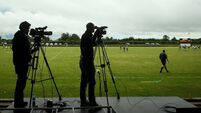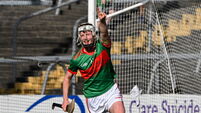Canning and Hayes key to Galway’s hopes
In his games so far Canning has spent the first quarter inside near goal and then he has been given a free role but for it to work his colleagues must supply good quality ball as often as possible and set him up in one-on-one situations with his marker.
The only way to make this happen is to avoid the long-ball game and play a short precise passing game from the defence to set up Galway’s half forwards and put Canning in front of goal. An early Galway goal would put them in prime position and heap pressure on the champions.
But there’s one problem with this. Kilkenny will have learned from the Leinster final and will keep bodies back defending their goal. If they get a lead they will employ a defensive system by dropping their half-forward line deep into midfield and closing the avenues for goals.
The only way to get back into a contest against the Cats in this scenario is to fire over long range points.
The defensive strategy gifts over possession around the middle and that’s where Cunningham will place Canning in that scenario. Deploying him almost as a double centre back, where he would be difficult to mark and could break in support of his half-back colleagues receiving passes, would allow him pick off long-range points.
Goals normally win matches but scored frees and good support play may win this one. If I was Anthony Cunningham I would advise Hayes and Canning that, if they are physically held or heavily challenged, to go down early and often as referees give easier frees to big name players and they don’t come any bigger than Joe Canning.
Kilkenny will seek to replicate the start they had against Tipp in last year’s final bringing huge intensity to their tackling, particularly in the forwards. Defenders don’t like to be pressurised and if support doesn’t come quickly they get isolated and turn over possession.
The crucial thing with that is it is almost as big a psychological boost for the team as the scores that come from it. Intensive pressure causes defenders to supply poor ball to their forwards which is easily intercepted by good half backs and Kilkenny defenders thrive on this.
Their plans have always revolved around early goals. They run directly at the defence and offload to supporting players who make well-timed clever angled runs and provide a deadly finish. Then they employ their aforementioned defensive system which provides massive cover for their defence and creates exploitable space for the two or three forwards left inside their opponents half.
Henry Shefflin and Eoin Larkin will hope to see that space against the relatively inexperienced duo of full back Kevin Hynes and corner Johnny Coen, who was taken for three handy points against Cork. I’m expecting the Noresiders to target these two.
I’m also expecting them to have plans in place to deal with Hayes. He has been outstanding in his third midfielder role this championship and was one of Kilkenny’s main tormentors in the Leinster final. They have two choices. Play a man marker like Jackie Tyrrell on him or flood the midfield by dropping Richie Power and TJ Reid back. The second option would allow Power and Reid get into space to run at their markers and that would be their most dangerous attacking ploy.
The presence of Mick Fennelly, injured for the Leinster final, in a congested four-man midfield area could stop Hayes at source and allow Tyrrell to play in front of Joe Canning as a sweeper with JJ Delaney in behind.
If I was Brian Cody I’d go for that second option keeping their normal defensive shape, absent on Leinster final day but so vital to their success over the years.
The main battle area will be the sector between the two 45 metre lines with lots of bodies in the way. Neither team can afford to give space to the opposition here to launch attacks as conceding an early lead will be fatal to their respective chances.
Galway had the better of this sector the last day but Kilkenny will have a better structure to their set up this time around, although Michael Rice is a loss.
The main battle is between Mick Fennelly and Iarla Tannian. Fennelly has it all as a midfielder, 6’3” in height, strength and an engine that allows him to travel from 20m line to other 20m line effortlessly augmenting the attack or defence as the occasion demands.
Tannian, another big man who played a lot of his underage hurling at midfield, seems more comfortable here than in the attack. But this will be his greatest challenge. Self belief, as always, will be important but winning the midfield battle may well decide the war.



